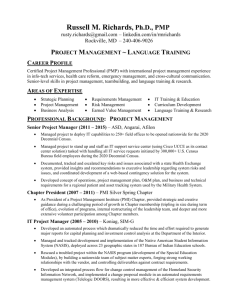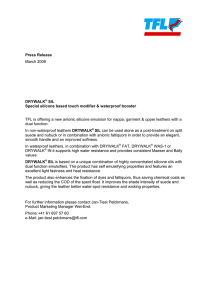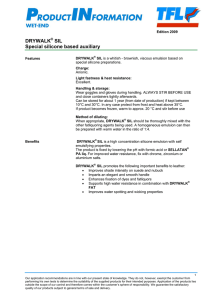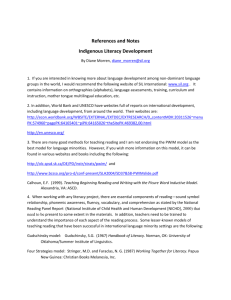Safety Integrity Level
advertisement
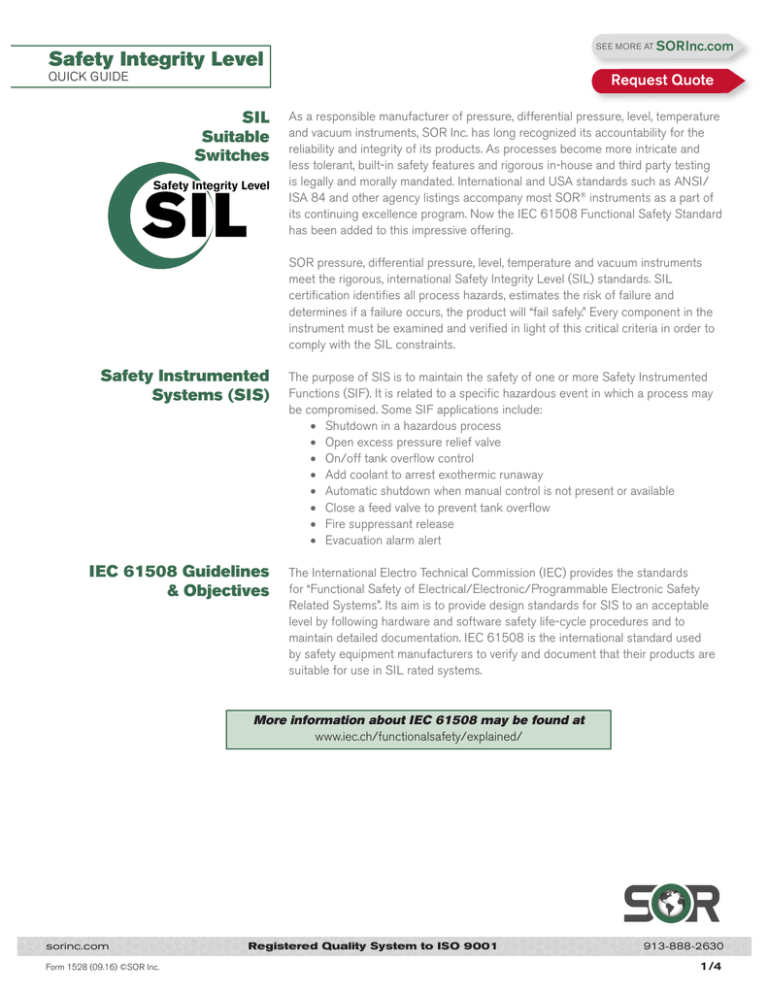
SEE MORE AT SORInc.com Safety Integrity Level QUICK GUIDE SIL Suitable Switches Request Quote As a responsible manufacturer of pressure, differential pressure, level, temperature and vacuum instruments, SOR Inc. has long recognized its accountability for the reliability and integrity of its products. As processes become more intricate and less tolerant, built-in safety features and rigorous in-house and third party testing is legally and morally mandated. International and USA standards such as ANSI/ ISA 84 and other agency listings accompany most SOR® instruments as a part of its continuing excellence program. Now the IEC 61508 Functional Safety Standard has been added to this impressive offering. SOR pressure, differential pressure, level, temperature and vacuum instruments meet the rigorous, international Safety Integrity Level (SIL) standards. SIL certification identifies all process hazards, estimates the risk of failure and determines if a failure occurs, the product will “fail safely.” Every component in the instrument must be examined and verified in light of this critical criteria in order to comply with the SIL constraints. Safety Instrumented Systems (SIS) The purpose of SIS is to maintain the safety of one or more Safety Instrumented Functions (SIF). It is related to a specific hazardous event in which a process may be compromised. Some SIF applications include: • Shutdown in a hazardous process • Open excess pressure relief valve • On/off tank overflow control • Add coolant to arrest exothermic runaway • Automatic shutdown when manual control is not present or available • Close a feed valve to prevent tank overflow • Fire suppressant release • Evacuation alarm alert IEC 61508 Guidelines & Objectives The International Electro Technical Commission (IEC) provides the standards for “Functional Safety of Electrical/Electronic/Programmable Electronic Safety Related Systems”. Its aim is to provide design standards for SIS to an acceptable level by following hardware and software safety life-cycle procedures and to maintain detailed documentation. IEC 61508 is the international standard used by safety equipment manufacturers to verify and document that their products are suitable for use in SIL rated systems. More information about IEC 61508 may be found at www.iec.ch/functionalsafety/explained/ sorinc.com Form 1528 (09.16) ©SOR Inc. Registered Quality System to ISO 9001 913-888-2630 1/4 SIL Explained A Safety Integrity Level is determined via a procedure called Risk/Process Hazard Analysis (PHA). It identifies all the hazards of a process and estimates the risks inherently involved and determines if that risk is tolerable/acceptable. This safety procedure must verify that each instrument utilized in the system (SIS) as well as each instrument’s parts such as sensors, logic solvers and integral components will work safely to achieve the Safety Instrumented Functions (SIF) in compliance with the confines required by SIL. For each instrument used within a SIS, the analysis team must concentrate their evaluation on the design and performance of its Safety Failure Fraction (SFF) and Probability of Failure on Demand (PFDavg). Every device in the SIF must meet or surpass the safety standards in both categories required by SIL to achieve SIL recognition. SIL standards allow for a manufacturer’s proven, in-use data that demonstrates reliability as well as fully assessed, third party analysis. Although SIL is a powerful, peace-of-mind benefit, it is always the end-user’s responsibility to verify and document all calculations for the entire SIS safety loop. All instruments/devices in a SIF loop must work together to meet the SIL requirement. 4 SIL Levels SIL certification is a tool to measure the amount of risk reduction provided by a Safety Instrumented Function. It assesses the tolerable/acceptable failure rate of an individual device. This is important when installing or retrofitting an instrument into a SIS. The SIL level number is based on the amount of risk reduction needed to maintain an acceptable rate of failure. Each of the 4 levels of SIL represents an order of magnitude of risk reduction – the higher the level, the greater the impact a failure (and thereby, the lower the acceptable failure rate). SIL 4 has the highest level of safety – Level 1 the lowest. With the use of the Safe Failure Fraction and Probability of Failure on Demand values calculated during the product design and evaluation, SIL levels are determined using charts within the IEC 61508 standard. SOR evaluated their switches with Type A and low demand constraints. Safe Failure Fraction Architectural constraints on Type A safety-related subsystems Safe Failure Fraction Hardware Fault Tolerance* 0 1 2 < 60% SIL1 SIL2 SIL3 < 60% - < 90% SIL2 SIL3 SIL4 90% - < 99% SIL3 SIL4 SIL4 > 99% SIL3 SIL4 SIL4 (Reference 61508-2 in the IEC Standards) * A hardware fault tolerance of N means that N + 1 faults could cause a loss of the safety function. Probability of Failure on Demand Target failure measures for a safety function operating in low demand mode of operation Safety Integrity Level (Average probability of failure to perform its design function on demand) 4 > 10-5 to < 10-4 3 > 10-4 to < 10-3 2 > 10-3 to < 10-2 1 > 10-2 to < 10-1 Low demand mode of operation (Reference 61508-1 in the IEC Standards) sorinc.com 2/4 Registered Quality System to ISO 9001 913-888-2630 Form 1528 (09.16) ©SOR Inc. Assessing your SIL Level needs SIL Levels To determine the risk reduction needed in your process operation as required by IEC 61508, a Failure Modes, Effects and Diagnostic Analysis (FMEDA) report serves as a systematic tool to methodically assess the effects of all probable and known failure modes. The report includes on-line monitoring and error-checking of SIS components. An FMEDA report aids you in evaluating the estimated failure rates, failure modes and diagnostic capabilities of an instrument/device to fit your process demands. It provides detailed circuit and performance data specific to the instrument/device and its components. SOR has the following SIL Level Certification on these Type A Device - Low Demand Mode Use products. Products Model SIL Level SFF* PFD* Pressure Big Hermet, Mini Hermet 2 0.60 7.80E-05 Sub-Mini Hermet 2 0.60 7.80E-05 General Pressure, OMNI 2 0.60 7.80E-05 Dual Hi-Lo Pressure 2 0.60 7.80E-05 Adjustable Dead-band 2 0.60 7.80E-05 Pivot Seal 2 0.60 7.80E-05 Opposed Piston DP 2 0.67 1.28E-04 Series 20 DP 2 0.67 1.28E-04 Model 102/103 DP 2 0.67 1.28E-04 Model 101/121 DP 2 0.67 1.28E-04 Model 107 DP 2 0.67 1.28E-04 2 0.62 1.37E-04 Dual Hi-Lo Temperature 2 0.62 1.37E-04 Vacuum General Vacuum 2 0.64 6.85E-05 Large Level Model 700, 730 and 750 Displacer Operated, Top-Insertion 2 0.66 2.41E-04 Model 740 and 800 Displacer Operated, Chambered 2 0.74 1.76E-04 Model 300 Float Operated, Top-Insertion 2 0.62 1.89E-04 Model 100 and 200 Float Operated, Chambered 2 0.72 1.89E-04 Model 400 Float Operated, Horizontal-Insertion 2 0.6 1.32E-04 Model 108 and 208 Float Operated, Horizontal Chambered 2 0.71 1.32E-04 Model 1510 1 0.34 4.83E-06 Model 1550 1 0.34 4.83E-06 Model 1710 2 0.63 5.70E-05 Model 2210 2 0.63 5.71E-05 Model 1520 1 0.50 4.83E-06 Model 900 - Vane Operated 2 0.72 7.46E-05 Differential Pressrure Temperature General Temperature Small Level Flow * SFF and PFD values noted are worst case for the product grouping listed above. For calculated values applicable to a specific product, please visit sorinc.com. sorinc.com Form 1528 (09.16) ©SOR Inc. Registered Quality System to ISO 9001 913-888-2630 3/4 Proof Tests To maintain the necessary SIL Level in any SIS, the system (and each component within the system) must be functionally tested for correct operation. The method to perform this functional testing is called “Proof Testing”. This testing is to be performed on the system and each product at intervals not greater than the period mandated by each device manufacturer. This “Proof Test Interval” is applied when calculating the PFD and determining a SIL level, thus it may be different for each device in the SIS and the entire system should be evaluated to determine the overall test interval. The “Proof Test Interval” used for the calculation of all SOR SIL ratings is once per year. To allow for future auditing and review of the performance of any SIS, the results of all Proof Testing should be recorded and retained for future evaluation. Proof Testing of SOR Products SOR switches are simple devices with snap acting “on/off” operation. Confirmation of required function only involves increasing or decreasing the process with which the device is installed to measure (pressure, temperature, level, flow). For an increasing set point, start at a process lower than set point and increase until the device changes state. Next, decrease process until the device resets. For a decreasing set point, start at a process higher than set point and decrease until the device changes state. Next, increase process until the device resets. If the found calibration of set point is as required, the proof test is complete; record data and move on to the next device. If calibration is found out of tolerance, recalibrate following the directions provided within the General Instructions document for the device. Note: Testing may be performed as installed or the switch may be required to be removed from service and tested on a calibration bench. The method used will be determined by the limitations of the SIS. The SOR Tradition of Continuing Excellence Manufacturing integrity, rugged construction and reliability has long been the foundation of SOR pressure, differential pressure, level, temperature and vacuum switches. It is what has made it the brand of choice for customers throughout the world for more than 60 years. Whether your instrumentation needs call for new or replacement or primary or redundant switches, you can be confident in your choice to go with SOR. The addition of the SIL rating just makes your decision easier. To learn more about SOR instruments for the process industry, contact your local SOR Representative or visit sorinc.com. sorinc.com 4/4 Registered Quality System to ISO 9001 913-888-2630 Form 1528 (09.16) ©SOR Inc.
